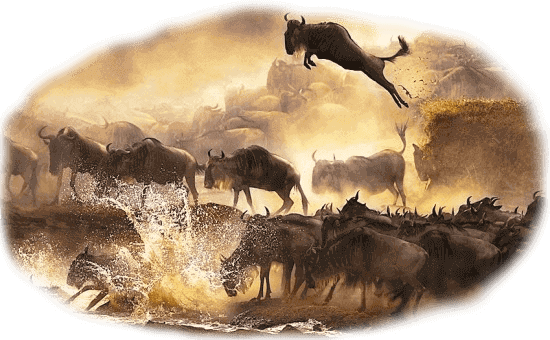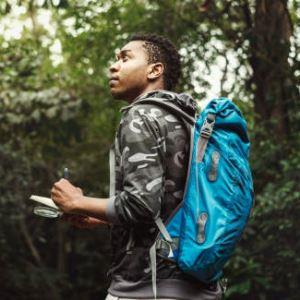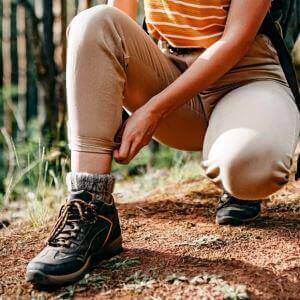 The best time for UK tourists to witness the Great Migration in Kenya is between July and October. During this period, millions of wildebeest move across the Mara River in dramatic crossings that attract large predators and thrill wildlife enthusiasts. These months offer the clearest viewings of the migration in the Maasai Mara, aligning perfectly with the dry season, when vegetation is sparse and animals gather near water sources. For visitors, this means more frequent and spectacular game sightings. This seasonal window aligns well with the UK’s summer holidays and half-terms, making it convenient for families and school schedules. July marks the arrival of the herds into the Maasai Mara from the Serengeti, and by August, the famous river crossings are in full swing. September and October continue the action as herds remain in the area, and predator-prey activity peaks. Early booking is essential, as this is the busiest safari season, and lodges in prime locations are often fully reserved months in advance. While July through October is the most popular time, late June offers an early glimpse of the migration without the peak season crowds. November and early December, though slightly wetter due to the short rains, still present good opportunities to see the tail end of the migration, especially in the northern and central parts of the Maasai Mara. The landscapes are greener, and there are fewer tourists, offering a more tranquil safari experience. UK travellers benefit from a variety of travel options to Kenya, including direct flights to Nairobi and smooth domestic transfers to safari regions. The journey is relatively short compared to other safari destinations, and many camps and lodges cater specifically to British visitors, offering familiar hospitality and comfort. It is important to note that the Great Migration is a continuous movement, not a static event. It flows through the Serengeti-Mara ecosystem and is driven by rainfall patterns. Those seeking to understand the migration in its full scope might consider extending their safari to include Tanzania, particularly during the calving season in January through March in the southern Serengeti. The optimal time for UK tourists to see the Great Migration in Kenya is during the dry months from July to October. However, with a bit of flexibility, excellent experiences can still be found on either side of this peak window. With expert planning, Kenya delivers a life-changing safari that blends awe-inspiring wildlife moments with cultural richness and natural beauty.
The best time for UK tourists to witness the Great Migration in Kenya is between July and October. During this period, millions of wildebeest move across the Mara River in dramatic crossings that attract large predators and thrill wildlife enthusiasts. These months offer the clearest viewings of the migration in the Maasai Mara, aligning perfectly with the dry season, when vegetation is sparse and animals gather near water sources. For visitors, this means more frequent and spectacular game sightings. This seasonal window aligns well with the UK’s summer holidays and half-terms, making it convenient for families and school schedules. July marks the arrival of the herds into the Maasai Mara from the Serengeti, and by August, the famous river crossings are in full swing. September and October continue the action as herds remain in the area, and predator-prey activity peaks. Early booking is essential, as this is the busiest safari season, and lodges in prime locations are often fully reserved months in advance. While July through October is the most popular time, late June offers an early glimpse of the migration without the peak season crowds. November and early December, though slightly wetter due to the short rains, still present good opportunities to see the tail end of the migration, especially in the northern and central parts of the Maasai Mara. The landscapes are greener, and there are fewer tourists, offering a more tranquil safari experience. UK travellers benefit from a variety of travel options to Kenya, including direct flights to Nairobi and smooth domestic transfers to safari regions. The journey is relatively short compared to other safari destinations, and many camps and lodges cater specifically to British visitors, offering familiar hospitality and comfort. It is important to note that the Great Migration is a continuous movement, not a static event. It flows through the Serengeti-Mara ecosystem and is driven by rainfall patterns. Those seeking to understand the migration in its full scope might consider extending their safari to include Tanzania, particularly during the calving season in January through March in the southern Serengeti. The optimal time for UK tourists to see the Great Migration in Kenya is during the dry months from July to October. However, with a bit of flexibility, excellent experiences can still be found on either side of this peak window. With expert planning, Kenya delivers a life-changing safari that blends awe-inspiring wildlife moments with cultural richness and natural beauty.
How Long Does the Great Migration Last in Kenya?
| Month | Activity in Migration Cycle | Ideal Viewing Location |
|---|---|---|
| January-March | Calving in Southern Serengeti | Ndutu Area (Tanzania) |
| April-May | Herds start moving north | Central Serengeti |
| June | Entry into Western Corridor, Grumeti River | Grumeti (Tanzania) |
| July-August | Mara River crossings begin | Maasai Mara (Kenya) |
| September | Herds remain in Mara | Northern Maasai Mara |
| October | Herds prepare return | Maasai Mara/Serengeti border |
| November | Move back to Serengeti | Southern Mara |
| December | Settling in south Serengeti | Ndutu Area (Tanzania) |
Key Migration Months to Plan Your Kenya Safari From the UK
Planning a safari from the UK to Kenya requires understanding the precise timing of the Great Migration. This epic wildlife event, a circular journey of over 1.5 million wildebeest, occurs year-round but peaks in specific months depending on the location within the Maasai Mara-Serengeti ecosystem. Here are the most crucial months for UK tourists to consider:
- July to October: This is the peak migration season and the most rewarding period for game viewing. During these months, wildebeest cross the Mara River in dramatic, adrenaline-filled scenes. Crocodiles lurk in the waters, while lions and other predators follow the herds, making this an unmatched time for witnessing raw nature in action. The savannah is dry, making it easier to spot wildlife, and UK tourists find this period convenient as it coincides with the UK summer break and half-term holidays.
- Late June: This is the lead-up to the main event, when the first herds begin arriving in the Maasai Mara from Tanzania’s Serengeti. It is ideal for those who prefer fewer crowds and a quieter safari experience. Although the river crossings might not be in full swing yet, the sightings are still plentiful, and the atmosphere is calm and photogenic, with golden light and open skies.
- November to December: As the short rains begin, the herds start to disperse and move southward back into Tanzania. While the mass river crossings are over, this period still offers excellent wildlife viewing, especially in the northern and central regions of the Mara. The landscape becomes lush and green, offering a beautiful contrast for photography, and the tourist density drops, making the experience more serene and intimate.
UK travellers often combine this period with summer holidays or October half-terms. Advance planning is essential as lodges fill fast during these peak periods.
How to Time Your Trip to Kenya for the Wildebeest Migration
Timing your trip from the UK to Kenya to witness the Wildebeest Migration is all about syncing your travel dates with the migration’s key phases. The movement of wildebeest and other grazing animals is not rigidly scheduled; it flows with the region's rainfall and vegetation patterns. Still, clear patterns emerge each year that make it easier for UK visitors to plan with confidence. From July to October, the wildebeest herds gather in Kenya's Maasai Mara, having journeyed from Tanzania's Serengeti. This period is famed for the Mara River crossings, dramatic scenes where thousands of animals brave crocodile-infested waters while predators lurk nearby. These months align well with the UK’s school summer holidays, making them especially attractive for family travel. If you aim to capture the migration's most intense and iconic moments, late July through early September is ideal. June presents a quieter but still rewarding opportunity. This is when the first herds start arriving in the Mara. The crowds are lighter, accommodations are slightly more available, and the experience feels more intimate. It's a fantastic choice for couples, photographers, or seasoned safari-goers looking to avoid the busier high season. November and December signal the start of the short rains, and the herds begin their slow retreat into Tanzania. While the bulk of the crossings have passed, this time still offers incredible wildlife interactions. The greenery returns to the landscape, providing stunning photographic backdrops, and with fewer tourists, safari drives feel more exclusive. For UK travellers, this shoulder season coincides with school half-terms and offers more affordable travel packages. The Wildebeest Migration is not just a Kenyan phenomenon but a shared cycle between Kenya and Tanzania. January through March is calving season in the southern Serengeti. While not part of Kenya, this phase is essential for understanding the full migration cycle. Some UK visitors opt for dual-country itineraries to witness both the drama of the crossings and the wonder of new life during calving. No matter which part of the migration you aim to see, logistics matter. From the UK, Kenya is accessible via direct flights to Nairobi, with well-managed domestic connections to the Maasai Mara. Choosing the right local guide and camp is crucial; many safari companies, curate travel experiences designed specifically for UK preferences and timing. With smart planning and the right timing, a trip from the UK to see the Great Migration in Kenya becomes more than a holiday, it becomes a timeless encounter with nature’s grandest performance.
Weather in Kenya During the Great Migration
Understanding the weather in Kenya is key to planning an ideal safari, especially when aligning your travel with the Great Migration. Kenya’s climate is largely dictated by its equatorial location, elevation, and regional microclimates. For UK travellers unfamiliar with equatorial weather patterns, it helps to view Kenya's seasons in terms of rainfall rather than temperature, as the variation in temperature is relatively mild throughout the year.
- June to October: This is Kenya's long dry season and the most favourable time for safari travel. Temperatures in the Maasai Mara typically range between 20°C and 26°C. Days are sunny and warm, while evenings can be cooler, particularly in higher altitudes. Wildlife is easier to spot during this period as animals cluster around permanent water sources, and the thinner vegetation allows for unobstructed views. It is also the time of the dramatic Mara River crossings, making it a prime window for those wanting to catch the migration at its most intense.
- November to December: Known as the short rainy season, these months bring brief but often heavy showers, usually in the late afternoon or early evening. The rain revives the parched plains, transforming the landscape into a lush green paradise. Wildlife remains abundant, especially in the northern and central parts of the Maasai Mara, where the tail end of the migration may still be seen. While river crossings are rare during this time, the vibrant landscapes and reduced tourist traffic can provide a more peaceful safari experience. This period is also popular for photographers looking for contrast and colour.
- March to May: These are the long rains, and they mark the least recommended time for a Kenyan safari. Heavy rainfall can lead to impassable roads and flooded camps, particularly in more remote areas. However, for those willing to embrace the challenge, this season is exceptional for birdwatching. Migratory birds arrive in large numbers, and the rich, green landscapes are a refreshing departure from the typical dry-season vistas. Some luxury lodges remain open and offer deep discounts, making it a viable option for seasoned travellers seeking solitude and lower costs.
For UK tourists, the best experience coincides with the dry months, where travel is more predictable, game viewing is optimal, and comfort is ensured. Planning your trip around Kenya's weather patterns not only increases the chances of witnessing the Great Migration in its full glory but also enhances the overall safari experience with better visibility, accessibility, and wildlife density.
Advantages of Visiting Kenya During the Migration Season
 Visiting Kenya during the Great Migration season is a profoundly enriching experience, especially for travellers coming from the UK. The migration season offers an unmatched opportunity to witness one of the world’s most dramatic wildlife spectacles, while also enjoying the best of Kenya’s climate, landscapes, and safari infrastructure. Every moment during this time pulses with life, movement, and drama, as the Maasai Mara becomes the stage for nature's most compelling theatre. One of the key advantages is the sheer density and diversity of wildlife that converges in the Maasai Mara during this season. Over 1.5 million wildebeest, accompanied by hundreds of thousands of zebras, gazelles, and elands, move in synchronized patterns, followed closely by predators like lions, leopards, cheetahs, and hyenas. For photographers, documentarians, and wildlife enthusiasts, it’s an unparalleled window into the dynamics of the African savannah. Another significant benefit is the heightened predator activity. As the herds arrive and begin crossing the Mara River, predators become more active and easier to spot. The big cats, particularly lions and cheetahs, engage in dramatic hunts that are rarely seen at other times of the year. Crocodiles, hidden beneath the river's surface, strike at unsuspecting wildebeest mid-crossing. These intense interactions offer a thrilling layer to the safari experience, appealing to visitors who seek more than passive wildlife observation. The migration season also allows for immersive ecosystem engagement. Beyond the well-known species, travellers witness countless other animals taking part in or benefiting from the migration. Elephant herds, giraffes, jackals, bat-eared foxes, and over 500 species of birds all contribute to the incredible biodiversity that thrives during this peak season. The bush itself is more open during the dry months, allowing for excellent visibility and more engaging game drives. UK tourists also enjoy practical travel benefits during this period. The dry weather between July and October ensures smoother travel conditions, with minimal disruption from rain. Safari lodges and camps are fully operational, and many cater specifically to the expectations of international visitors, including British travellers, by offering familiar cuisine, efficient service, and English-speaking guides. Additionally, the season coincides with UK school holidays, making it ideal for family travel without requiring time off during term. Visiting during the migration also creates emotional impact. Witnessing thousands of animals in motion, risking everything to survive, evokes awe and a deeper appreciation for the wild. For many UK tourists, this is not just a holiday but a life-changing encounter that brings new perspective and inspiration. With professional planning and local insight, Kenya during the migration becomes an unforgettable, transformative journey.
Visiting Kenya during the Great Migration season is a profoundly enriching experience, especially for travellers coming from the UK. The migration season offers an unmatched opportunity to witness one of the world’s most dramatic wildlife spectacles, while also enjoying the best of Kenya’s climate, landscapes, and safari infrastructure. Every moment during this time pulses with life, movement, and drama, as the Maasai Mara becomes the stage for nature's most compelling theatre. One of the key advantages is the sheer density and diversity of wildlife that converges in the Maasai Mara during this season. Over 1.5 million wildebeest, accompanied by hundreds of thousands of zebras, gazelles, and elands, move in synchronized patterns, followed closely by predators like lions, leopards, cheetahs, and hyenas. For photographers, documentarians, and wildlife enthusiasts, it’s an unparalleled window into the dynamics of the African savannah. Another significant benefit is the heightened predator activity. As the herds arrive and begin crossing the Mara River, predators become more active and easier to spot. The big cats, particularly lions and cheetahs, engage in dramatic hunts that are rarely seen at other times of the year. Crocodiles, hidden beneath the river's surface, strike at unsuspecting wildebeest mid-crossing. These intense interactions offer a thrilling layer to the safari experience, appealing to visitors who seek more than passive wildlife observation. The migration season also allows for immersive ecosystem engagement. Beyond the well-known species, travellers witness countless other animals taking part in or benefiting from the migration. Elephant herds, giraffes, jackals, bat-eared foxes, and over 500 species of birds all contribute to the incredible biodiversity that thrives during this peak season. The bush itself is more open during the dry months, allowing for excellent visibility and more engaging game drives. UK tourists also enjoy practical travel benefits during this period. The dry weather between July and October ensures smoother travel conditions, with minimal disruption from rain. Safari lodges and camps are fully operational, and many cater specifically to the expectations of international visitors, including British travellers, by offering familiar cuisine, efficient service, and English-speaking guides. Additionally, the season coincides with UK school holidays, making it ideal for family travel without requiring time off during term. Visiting during the migration also creates emotional impact. Witnessing thousands of animals in motion, risking everything to survive, evokes awe and a deeper appreciation for the wild. For many UK tourists, this is not just a holiday but a life-changing encounter that brings new perspective and inspiration. With professional planning and local insight, Kenya during the migration becomes an unforgettable, transformative journey.
Wildlife Viewing Opportunities Beyond the Migration
While the Great Migration is undoubtedly the crown jewel of a Kenyan safari, the country offers a wealth of wildlife viewing experiences outside this iconic event. Kenya's diverse ecosystems support rich animal life year-round, giving UK visitors a broader scope of travel options beyond the July to October migration window. Whether you’re returning for a second safari or scheduling travel outside the migration season, these locations promise rewarding, uncrowded and deeply engaging encounters with nature.
- Amboseli National Park: Nestled at the foot of Mount Kilimanjaro, Amboseli is renowned for its iconic elephant herds and dramatic landscapes. From January to February, the skies are typically clear, offering postcard-perfect views of Africa’s highest peak. The elephants here are known for their size and long tusks, and you can often see them walking in front of the mountain a photographer’s dream. The park also supports lions, cheetahs, hyenas and over 400 bird species, making it a balanced wildlife destination even outside migration months.
- Laikipia Plateau: This lesser-known gem lies northwest of Mount Kenya and is home to a range of private conservancies that focus on conservation and community-based tourism. It’s one of the best places in Kenya to track both black and white rhinos, which are more elusive in the Mara. Laikipia also shelters endangered species such as Grevy’s zebra and African wild dogs. The area is accessible year-round, with the dry spells from July to September offering particularly good visibility for game drives. UK travellers will appreciate the exclusivity, fewer vehicles and innovative safari experiences like camel trekking and bush walks.
- Lake Nakuru National Park: Known for its vibrant flamingo populations and rhino sanctuary, Lake Nakuru offers a unique mix of aquatic and terrestrial wildlife. It is most vibrant during the rainy seasons, when the lake's algae bloom attracts tens of thousands of flamingos, creating a breathtaking pink-hued spectacle. The surrounding forested hills provide shelter for leopards and colobus monkeys, while the open plains host buffaloes, giraffes and waterbucks. This park is ideal for a shorter safari and easily accessible from Nairobi, making it a practical add-on to a longer itinerary.
For UK safari-goers, these alternatives present exciting options that are less crowded, more budget-flexible, and equally rewarding. Travelling beyond the migration season not only allows for greater flexibility in scheduling around school or work but also reveals lesser-explored aspects of Kenya’s remarkable natural heritage.
Frequently Asked Questions About Optimal Time to Visit Kenya for the Great Migration
Planning your trip to witness the Great Migration from the UK involves understanding the timing, weather, wildlife behavior, and travel logistics. Below are voice-search-optimized questions with clear answers tailored for UK tourists seeking a seamless safari experience.
- When is the best month to see the Great Migration in Kenya? The best months are July to October. This is when wildebeest cross the Mara River, and predator activity peaks. August often sees the most dramatic crossings.
- Can I see the migration if I visit Kenya in June? Yes, late June is when the first herds arrive in the Maasai Mara. While river crossings may not have started, wildlife density increases, and crowds are fewer.
- Is November a good time for the Great Migration? November marks the start of the short rains and the migration's retreat to Tanzania. While fewer crossings occur, the Mara is still active with wildlife and stunning green landscapes.
- How long should I stay in Kenya to see the Great Migration? A minimum of 4–6 nights is recommended in the Maasai Mara to increase your chances of witnessing a river crossing and to enjoy varied game drives.
- What’s the weather like in Kenya during migration season? From July to October, the weather is dry and mild, ideal for safari. Temperatures range from 20°C to 26°C with cool evenings. It’s perfect for game viewing and photography.
- Can I still enjoy a safari outside the migration period? Absolutely. Parks like Amboseli, Laikipia, and Samburu offer exceptional wildlife year-round. January to March is ideal for calving season in Tanzania if you want to expand your itinerary.
- Are safaris during migration suitable for families from the UK? Yes. Many camps cater to families with child-friendly programs, UK-style cuisine, and guides trained in hosting younger guests. Travel during school breaks is common.
- Do I need to book my safari far in advance? For migration season (July–October), it is wise to book 6–12 months ahead. Lodges near the Mara River fill up quickly, and early planning secures better rates and locations.
These FAQs help answer common concerns from UK visitors looking to experience the Great Migration. With proper timing and local insight, the journey becomes a once-in-a-lifetime adventure.






